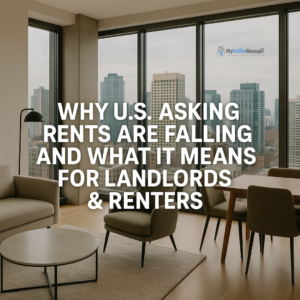After several years of relentless rent increases, the U.S. rental market is finally showing signs of cooling. According to the latest data from Redfin, the median asking rent fell by about 1% year-over-year in May 2025 to $1,625 the lowest level since early 2022. This marks a notable shift in the rental landscape, signaling that the power balance between landlords and tenants may be changing.
National Trend: A Shift After Years of Growth
For much of the past four years, rent growth seemed unstoppable. Driven by strong demand, limited inventory, and pandemic-era relocations, landlords had the upper hand in nearly every market. But now, the trend has reversed.
Redfin’s report shows that asking rents have either plateaued or fallen in most major metros, reflecting broader changes in supply and demand. The dip may appear small, but it’s significant considering the record rent levels of recent years.
The main reason? A nationwide construction boom. Thousands of new apartment units have entered the market, particularly in fast-growing Sun Belt metros like Austin, Phoenix, and Atlanta. As inventory expands faster than demand, landlords are being forced to compete not just on price, but on perks and service quality too.
Regional Differences: Some Markets Cooling, Others Still Hot
While the national average shows a slight decline, the story varies widely across the country:
-
Sun Belt Markets: Cities like Austin, Nashville, and Tampa have seen some of the sharpest rent declines, as new supply floods the market. Developers built aggressively during the pandemic, and now those units are coming online all at once.
-
Coastal Metros: Areas like New York City and San Francisco remain among the most expensive, though growth there has flattened. Limited space for new construction keeps these markets tight despite cooling demand.
-
Midwestern Cities: Affordable regions such as Cincinnati, Columbus, and Milwaukee have seen rents stay relatively stable, attracting renters priced out of coastal areas.
Even with these differences, one pattern stands out renter leverage is returning. With more options available, tenants can be selective and negotiate more favorable lease terms.
Why Rents Are Falling: Key Drivers
Several economic and structural factors are converging to bring rent prices down:
-
Increased Supply:
The U.S. is currently experiencing the largest wave of multifamily construction in decades. As these new units hit the market, the competition for tenants intensifies. -
Softening Demand:
With inflation easing and homebuying costs stabilizing, some renters are reconsidering their options including relocating, downsizing, or even purchasing a home. -
Economic Uncertainty:
Job growth has slowed in some sectors, prompting renters to be cautious about taking on higher monthly costs. -
Landlord Incentives:
To attract tenants, landlords are increasingly offering concessions like one month free, reduced deposits, or free parking. These discounts effectively reduce “real rent” even when advertised rates look stable. -
Remote Work Normalization:
As hybrid work persists, renters continue to migrate to smaller cities where they can get more space for less money, spreading out demand and cooling the pressure on big urban markets.
What This Means for Renters
For renters, this cooling trend offers long-awaited relief. While rent prices are still historically high, the slowdown provides opportunities to:
-
Negotiate better deals: Renters can often request longer lease terms with minimal increases or secure added amenities at no extra cost.
-
Shop for incentives: Many landlords are offering move-in bonuses or discounted rates for longer leases.
-
Explore new areas: Previously unaffordable neighborhoods or apartment types may now fit into your budget due to increased vacancy rates.
This is an ideal moment for renters to compare effective rent (after discounts) instead of just the listed rate. With more properties competing for attention, a little negotiation can go a long way.
What This Means for Landlords & Property Managers
For landlords and property management companies, this is a time to pivot strategy rather than panic. While rents are softening, this shift presents a valuable opportunity to focus on retention and differentiation.
Key actions to consider:
-
Prioritize Tenant Retention:
Keeping a good tenant is far cheaper than finding a new one. Offer renewal incentives, respond quickly to maintenance issues, and strengthen communication. -
Enhance Property Appeal:
Small upgrades like modern fixtures, better lighting, or improved curb appeal can make your units stand out in a crowded market. -
Leverage Data Analytics:
Use rental market data to track nearby competition and adjust pricing dynamically. Smart pricing ensures you stay competitive without undervaluing your property. -
Optimize Marketing:
Highlight your property’s strengths location, amenities, security, and management responsiveness in online listings. Professional photos and virtual tours can significantly boost interest. -
Plan for Leaner Margins:
Adjust financial forecasts to reflect slower rent growth. Managing expenses effectively will help maintain profitability even when rent increases are modest.
For management companies like McIntire Kingstone, this is also a good time to strengthen relationships with property owners, offering them transparent insights into how market shifts are being managed proactively.
Looking Ahead: Will Rents Continue to Drop?
Most experts expect moderate rent declines or flat growth through early 2026, as the wave of new apartment completions continues. However, once construction slows and absorption catches up, rents could start rising again albeit at a more sustainable pace.
Markets with strong job growth and limited new supply will likely stabilize first, while oversupplied regions may continue to see mild corrections.
The Bottom Line
The era of relentless rent hikes appears to be pausing at least for now. For renters, that means breathing room and more negotiating power. For landlords and managers, it’s a reminder to shift focus from pure rent growth to tenant experience, property quality, and operational efficiency.
Whether the rent dip continues or stabilizes, one thing is clear: flexibility and awareness will be the key to thriving in the next chapter of the rental market.
Source: Redfin Reports U.S. Asking Rents Fell 1% Year Over Year in May – Yahoo Finance

